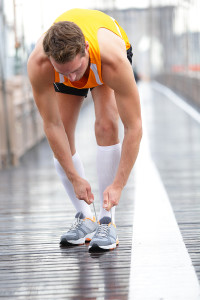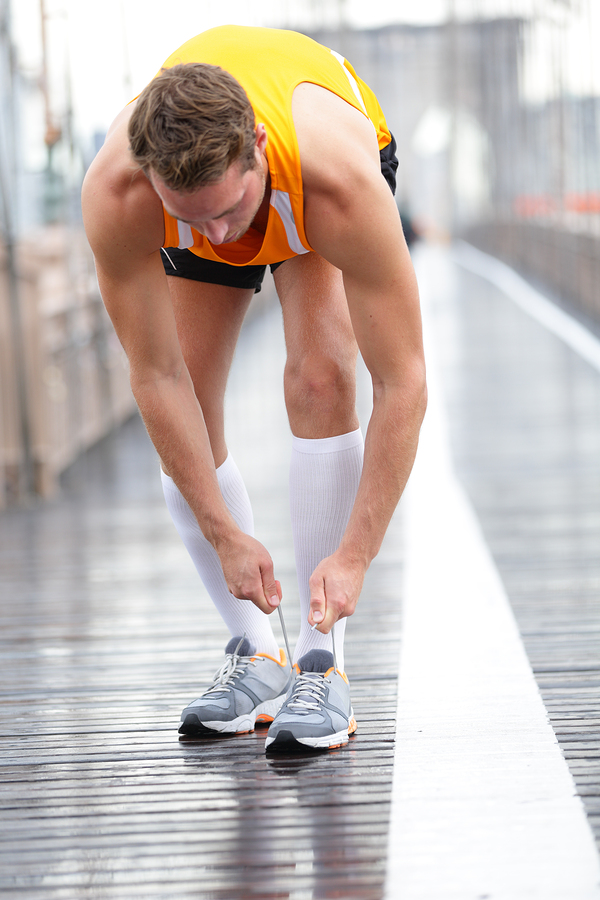How to Prevent Foot Blisters
 Foot blisters are common injuries, not just in sports, but also in everyday life. A blister can form when the amount of stress placed on the skin exceeds its strength. A common misconception is that a blister results from friction on the skin’s surface; in fact, the injury occurs due to the stretching of the soft tissue that lies between the skin and the bones. The result is an intra-epidermal split that fills with fluid. After a blister forms, superficial rubbing can then cause it to painfully “deroof.”
Foot blisters are common injuries, not just in sports, but also in everyday life. A blister can form when the amount of stress placed on the skin exceeds its strength. A common misconception is that a blister results from friction on the skin’s surface; in fact, the injury occurs due to the stretching of the soft tissue that lies between the skin and the bones. The result is an intra-epidermal split that fills with fluid. After a blister forms, superficial rubbing can then cause it to painfully “deroof.”
The soles of the feet are particularly susceptible to blisters for three main reasons. First, the skin in this area is designed to bear the body’s weight, so it is relatively thick and immobile. Second, the feet spend a good deal of time enclosed in shoes, and the typically hot and humid in-shoe climate can create a high level of friction. Finally, the nature of mobility is repetitive, and repetitive motion is the primary cause of blisters.
Perhaps due to their prevalence, or the fact that they “only affect the skin,” blisters are often not taken seriously – even when they are painful and limit daily activity. However, once a blister forms, it’s important to take steps to keep the roof intact so that it will be less painful and prone to infection. Of course, prevention is always the best approach. Here are some good blister prevention strategies:
- Wear proper-fitting shoes – A shoe that is too small can create extra pressure with less repetition, while a shoe that is too large can allow the foot to slide around too much. Optimal shoe fit involves length, width, and adjustability (important because foot volume generally increases during the course of activity).
- Wear appropriate socks – By design, socks increase friction to maintain traction for the foot in the shoe. However, some socks can be used to reduce friction. For instance, moisture-wicking socks made of synthetic fibers like polyester can help keep the skin dry by absorbing perspiration. On the other hand, natural fibers like cotton and wool tend to keep moisture trapped against the skin, creating an ideal climate for blisters. To help protect their feet, many athletes wear double socks, which can enhance the moisture-wicking function as well as add a “sock/sock interface” to further reduce friction.
- Add cushioned insoles – Cushioning can reduce pressure inside a shoe by effectively spreading the weight load over a larger area. But, it’s important to keep in mind that adding cushioned insoles to a well-fitting shoe can alter the fit.
- Try lubricants or powders – Moist skin – that is neither very wet nor very dry – can actually reduce friction. Lubricants like petroleum jelly can be helpful for this purpose. Conversely, cornstarch, foot powders, and antiperspirants can reduce friction by absorbing perspiration.
While the majority of blisters do not require medical attention, severe redness, swelling, pain, or pus can indicate the presence of an infection that requires antibiotic treatment.
At South Tampa Immediate Care, our experienced medical staff will be pleased to answer your questions about blister prevention and treatment, as well as any other health- or wellness-related topic. Our walk-in clinic is open Monday through Friday, 8 a.m. to 8 p.m., and weekends, 8 a.m. to 5 p.m., and no appointment is ever necessary to see one of our doctors.













